In 2023, Member States (MS) in the Region continued influenza preparedness in the context of implementation of the WHO Global Influenza Strategy (2019–2030) and Pandemic Influenza Preparedness (PIP framework) in alignment with the International Health Regulations (IHR) (2005). WHO’s coordinated efforts for synergies between influenza preparedness and pandemic response capacity-building were targeting achieving two high-level outcomes as outlined in the Global influenza strategy:
(1) Ensuring availability of better global tools for prevention, detection, control, and treatment of influenza and
(2) Building stronger country capacities through evidence-based influenza programmes established on the principle of universal coverage that meets national health security needs.
To supplement these efforts by provisions of the Pandemic Influenza Preparedness (PIP) Framework, Regional office continued to implement activities of the final year of the High-Level Implementation Plan (HLIP)- II (2018-23). In 2023, Regional office worked with the PIP Partnership Contribution (PC) secretariat to prioritize countries for receiving PC funds for the first biennium under the new HLIP-III (2024-30). In addition to seven eligible countries already receiving funds under HLIP-II (India, Nepal, Bangladesh, Timor Leste, Indonesia, Myanmar and DPR Korea), three more countries (Maldives, Sri Lanka, Bhutan) were prioritized to receive funds under HLIP-III.
In the strategic objective “Surveillance, monitoring and data utilization” in the Global Influenza strategy, WHE continued to work on the need for integrated sentinel surveillance for broad respiratory pathogens with primary focus on integrating influenza and SARS-CoV-2. In addition, WHE facilitated a pilot project on integrating Respiratory Syncytial Virus (RSV) surveillance to the existing Influenza Like Illness (ILI) and Severe Acute Respiratory Infection (SARI) sentinel surveillance network in three countries namely India, Nepal and Thailand. Overall concerted efforts focused on supporting MS to consolidate gains of integrating sentinel surveillance for broad respiratory pathogens, identifying needs, coordinating policy, strategic and technical support and determining steps for its sustainability within the Global Influenza Surveillance and Response System (GISRS) Network.
To provide policy and strategic guidance and better streamline these upstream activities pertaining to implementation of the Global influenza strategy operationally at the country level, the Regional Office for South East Asia (SEARO) together with WHO Regional Office for the Western Pacific (WPRO) conducted the “Sixteenth Bi-regional Meeting of National Influenza Centres (NIC) and Influenza Surveillance in the Western Pacific and South-East Asia Regions” in Dhaka, Bangladesh from 01-03 August 2023.
The meeting focused on
(1) reviewing the status of seasonal/non-seasonal and zoonotic influenza in both WHO regions
(2) agreeing with Member States and major stakeholders on key important actions required for strengthened influenza preparedness,
(3) determining the degree to which countries have integrated sentinel surveillance of influenza and SARS-CoV-2 with a view to identifying challenges and potential solutions in enrolment, testing , data sharing and use of information for epidemic/pandemic response.
(4) discussing current challenges in laboratory diagnosis of influenza and SARS-CoV-2 for sentinel surveillance, influenza virus sharing with WHO collaborating centres and plans on implementation of WHO recommended laboratory standards
(5) eliciting SEAR and WPR country - specific, potential challenges in the process of proposed conversion of the Global Influenza Surveillance and Response System (GISRS) to an expanded GISRS (eGISRS).
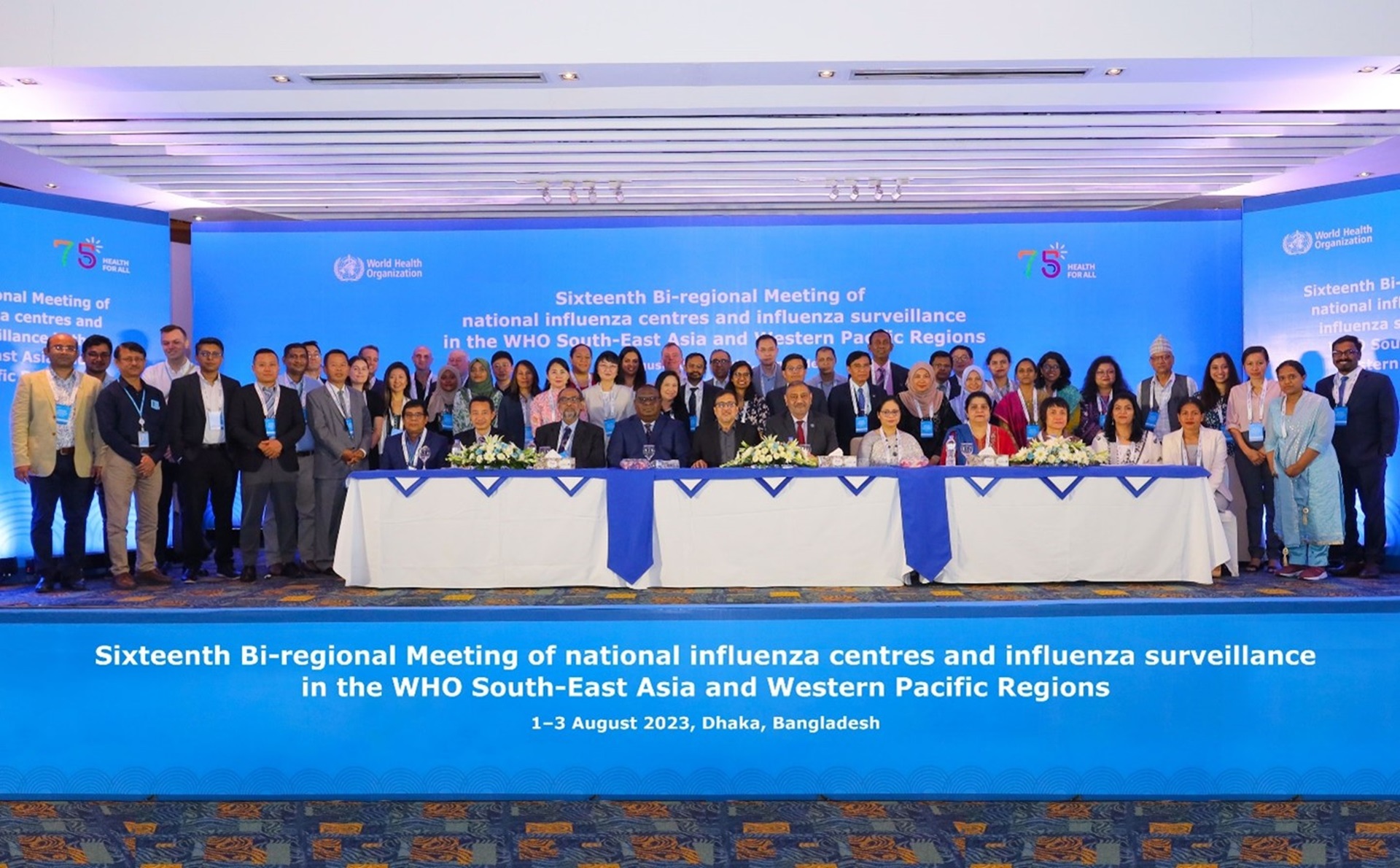
Sixteenth Bi-regional Meeting of National Influenza Centres (NIC) and Influenza Surveillance in the Western Pacific and South-East Asia Regions (Hybrid)” in Dhaka, Bangladesh from 01-03 August 2023. (Photo – IHM/WHE SEARO)
To accomplish the strategic objective “Pandemic preparedness and response” in the Global Influenza strategy, in October 2023, Recipient MS of PIP-PC funds from the South-East Asia Region came together in New Delhi for the annual meeting to
(a) review the progress of HLIP- II implementation,
(b) update Member States on new HLIP- III and
(c) discuss how best to implement HLIP-III through country specific work plans (2024-25) in SEAR for better and improved PIP outcomes in the region. While the meeting provided an opportunity for the independent global PIP Framework Advisory Group representatives to familiarize with the work done in the region, partners showcased how their contributions through collaboration with WHO helped improve PIP outcomes in MS in the region.
Since the launch of the Preparedness and Resilience for Emerging Threats (PRET) initiative and the delivery of a high-level Global call for action, WHE with the PRET secretariat at WHO Headquarters developed a roadshow for introducing implementation of the PRET initiative for adaptation by the MS in the region. It was started with an introductory webinar targeting National Focal Points of the IHR in all MS in the region.
Advancing further, WHE organized a Regional workshop on WHO’s Preparedness and Resilience for Emerging Threats (PRET) framework on 12-13 October 2023. Public health officials from nine countries and WHO Country Office participants from other two countries discussed their respiratory pathogen pandemic preparedness planning priorities in line with the South East Asia Regional Strategic Roadmap for Health Security and Health System Resilience for Emergencies 2023-2027 and WHO’s Preparedness and Resilience for Emerging Threats (PRET) initiative that promotes efficient mode-of-transmission pandemic planning. As an outcome of the meeting, all countries identified their immediate next steps and the support needed from WHO and partners to maximize regional preparedness.
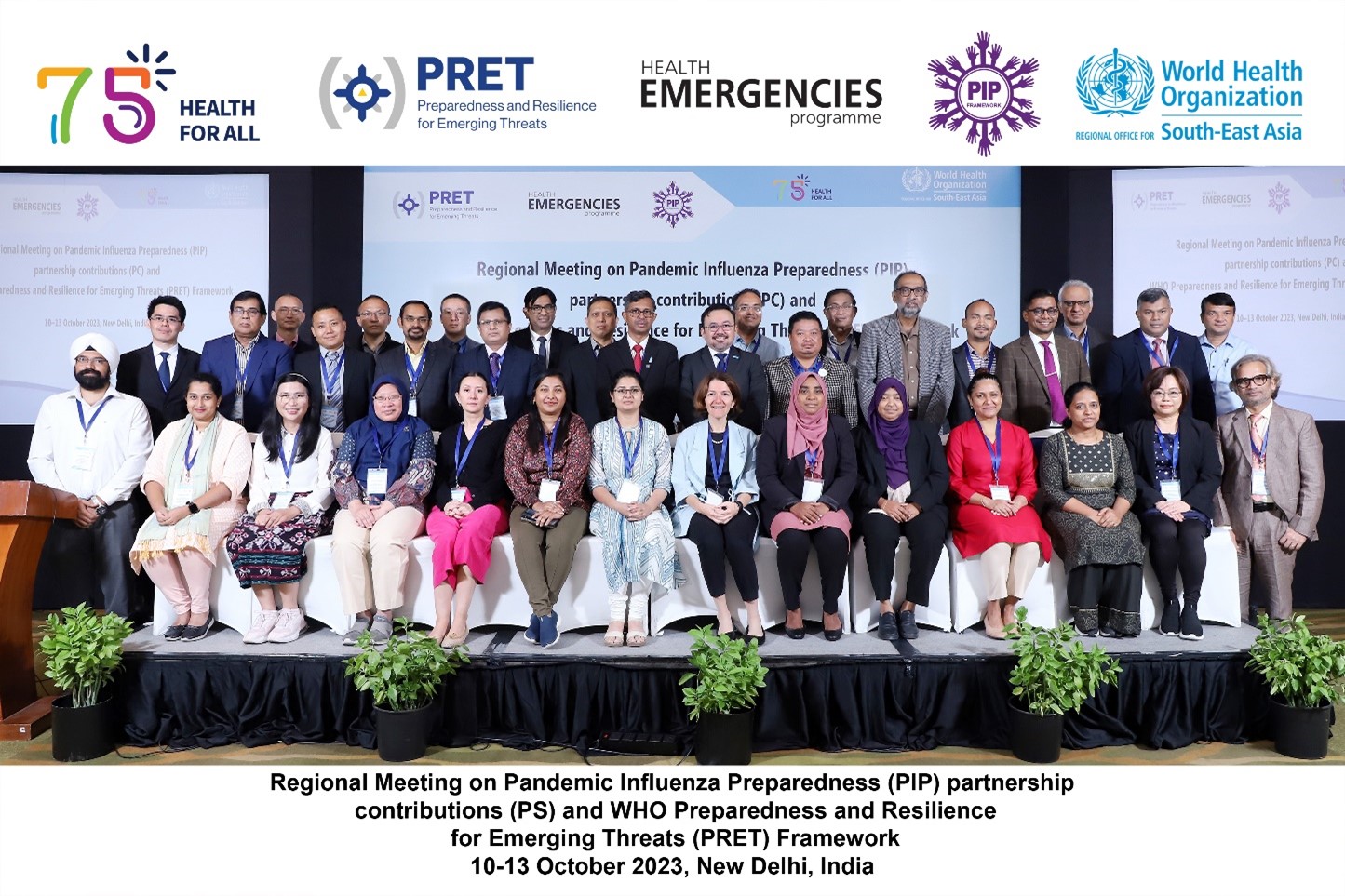
Regional meeting on Pandemic Influenza Preparedness (PIP) partnership contributions (PC) and WHO Preparedness and Resilience for Emerging threat framework (Hybrid) held on 10-13 October 2023 (Photo – IHM/WHE SEARO)
Subsequently, on 8-9 December 2023, the Ministry of Health and Welfare of the government of India and WHO country office India in collaboration with the WHE/SEARO, operationalized the PRET initiative through a “National Consultative Workshop on the "National Pandemic Preparedness Plan for Respiratory Viruses." In this meeting, there levels of WHO introduced the PRET initiative, shedding light on its significance and utility in addressing respiratory pandemic pathogen threats.
Under the strategic objective of “Surveillance, monitoring and data utilization” in the Global Influenza Strategy multiple efforts have been made by WHO, WHO Collaborating Centres and other partners to support MS to adhere to the threshold of processing at least 50 samples and preferably 150 samples per week for diagnosis of Influenza and SARS CoV 2 at the national level as recommended in the “WHO End-to-end integration of SARS-CoV-2 and influenza sentinel surveillance: revised interim guidance”. Appreciating the efforts of MS in adopting country specific approaches to implement the above guidance, “End-to-end integration of SARS-CoV-2 and influenza sentinel surveillance: compendium of country approaches” showcased best practices of Bangladesh, DPR Korea, India, Nepal and Timor Leste in SEAR.
Guided by the WHO’s interim guidance, the number of specimens processed for testing for influenza (and SARS-CoV- 2) in 2023 in SEAR MS was 83632 samples (median- 1693). This was 10% reduction in numbers processed in 2023 relative to that in 2022 (93198 samples; median- 1511). The observed difference was due to the increased number of samples processed by India during the surge of influenza transmission in the first 10 weeks of 2023 that ranged between 1029- 7116 samples per a week. The number of samples processed in all SEAR countries in 2023 was only 3% less than the annual threshold of 85800 based on the national threshold of 150 samples per NIC per a week. The same was 2.9-fold higher than the minimum recommended number of 28600 samples to be processed for the annum based on the threshold of 50 samples per NIC per a week as recommended in the “WHO End-to-end integration of SARS-CoV-2 and influenza sentinel surveillance: revised interim guidance”
The trend of samples processed for testing for influenza (and simultaneously for SARS-CoV-2) with multiplex real-time reverse transcription polymerase chain reaction (rt-PCR) assays for the period from 2022 to 2023 is given
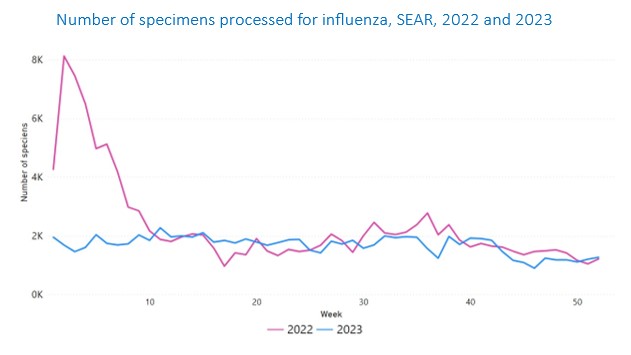
Number of specimens processed for testing for Influenza by weeks and years in WHO South-East Asia Region, 2022-2023. Source: WHO
To provide guidance to Member States to reduce seasonal influenza burden and its health and societal impact, the Regional Office continued to analyze the transmission pattern and characteristics of circulating seasonal influenza types and sub types. The seasonal influenza transmission pattern varied from country to country and even within geographical regions in big countries. In 2023, the region observed a bi-modal transmission of the virus. This was in contrast to uni-modal transmission pattern constructed in 2021 and 2022 which could be due to the disruption of surveillance and reporting to WHO in most of SEAR MS due to the COVID-19 pandemic.
The first peak of transmission in 2023 indicated by 16% positive specimens for influenza was observed in March while the much bigger peak with 33% positive specimens for influenza was observed in September. Despite the two peaks, seasonal influenza virus continued its transmission consistently throughout the year (% specimens positive for influenza virus- 8.4%- 33%) indicating the variability of transmission in different countries in the region which is heterogenous in terms of periods of transmission reflected in the cumulative regional transmission dynamics.
In 2023, influenza type A predominated circulation followed by Influenza type B(Victoria) and influenza type B (un-sub typed).
Number of specimens positive for Influenza by subtype and percentage positive in the South-East Asia Region in 2023 , Source: WHO
As per recommendations of the “WHO End-to-end integration of SARS-CoV-2 and influenza sentinel surveillance: revised interim guidance”, five countries (Bangladesh, Bhutan, Indonesia, Nepal, and Timor Leste) in the Region regularly reported results of SARS-CoV-2 detected through samples tested in their integrated ILI/SARI sentinel surveillance systems to the WHO global data reporting platform (RespiMART).
Results of the samples tested for SARS CoV 2 collected through the sentinel surveillance system based on ILI and SARI case definitions indicated that there was an increased test positivity in the region starting from March, peaking (13%) in mid-April and then gradually decreasing to remain positive consistently at low levels. Again towards the end of the year , ILI and SARI samples sourced through the sentinel surveillance system indicated a rising trend in test positivity for SARS CoV 2 .The South-East Asia Region specific influenza surveillance information is available at https://www.who.int/southeastasia/outbreaks-and-emergencies/infectious-hazard-management
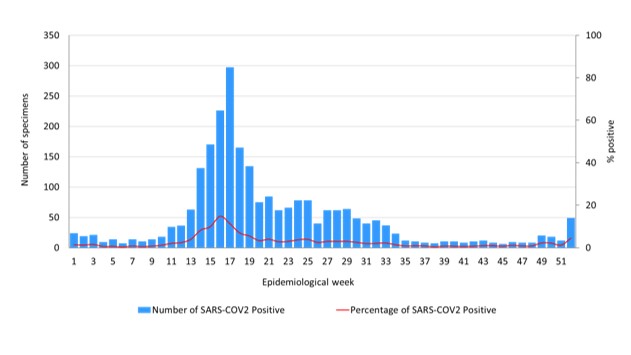
Number of specimens positive for SARS-COV2, and percentage positive in the South-East Asia Region in 2023 , Source: WHO
To strengthen country capacity in “Surveillance, monitoring and data utilization” as a strategic objective of the Global Influenza Strategy, WHE conducted a joint national and international influenza surveillance review and an influenza data management training in Maldives (Figure XX). Both these activities were supported by national experts and experts from Bangladesh, Nepal, Sri Lanka, Bhutan, United States Centres for Disease control and prevention (USCDC) and the Victoria Infectious Disease Reference Laboratory (VIDRL) -Melbourne, Australia.

National and international experts reviewed the ILI/SARI sentinel surveillance system and the Public Health laboratory at the Indira Gandhi Memorial Hospital in Maldives on 5-9 March 2023. (Picture – IHM/WHE, SEARO)
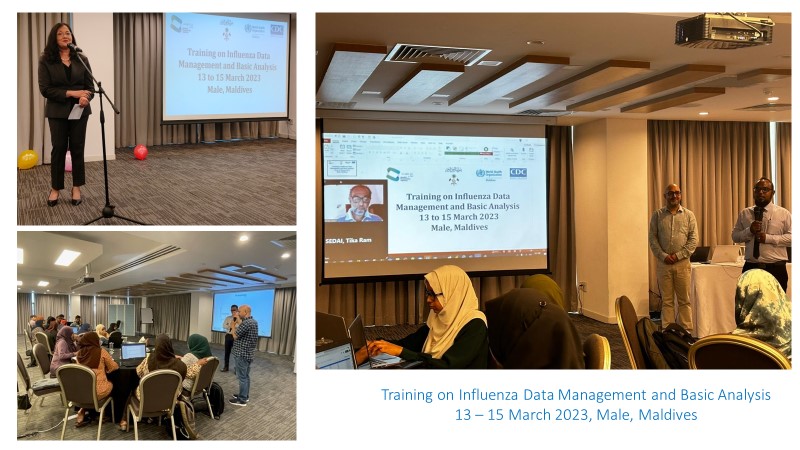
National and international experts conducted the training on influenza data management and basic analysis in Male, Maldives on 13-15 March 2023 (Photo-IHM/WHE, SEARO)
In terms of building stronger country capacities under the Global Influenza Strategy, 2023 was a remarkable year for the Region. By the end of 2023, National influenza centres (NICs) designated by national ministries of health in all 11 MS had been formally recognized by WHO as NICs to participate in the global platform of GISRS. Following
(a) WHO coordinated on-site assessments by independent experts from the MS and WHO Collaborating centres for reference and research on influenza and
(b) systematic implementation of an action plan to reach the required standards , the WHO Global Influenza Programme formally recognized last remaining three public health laboratories namely
(1) the National Influenza Laboratory at the Royal Centre for Disease Control, Bhutan
(2) Influenza Laboratory, at the Indira Gandhi Memorial Hospital, Maldives and (3) the Influenza Laboratory at the National Public Health Laboratory in Timo Leste as 150 151, 152nd NICs in the Global Influenza Surveillance and Response System (GISRS) respectively in 2023.
With the futuristic view of adding Respiratory Syncytial Virus (RSV) surveillance into the proposed system of integrated surveillance of broad respiratory viruses in the Region, WHE supported pilot projects in Nepal, Thailand, and India in the phase-2 of respiratory syncytial virus surveillance”.
To ensure the quality of influenza testing in laboratories, WHE continued to facilitate the participation of NICs and National Influenza laboratories from the Region in the External Quality Assurance Programme (EQAP) for Influenza organized by the Global Influenza Programme (GIP). Ten Member States participated in the programme. Similarly, EQAP for RSV was facilitated for pilot countries (Nepal, India, and Thailand) with WHO HQ while the opportunity being provided to non-pilot countries that were interested in participation. To advance the agenda of laboratory biosafety in the influenza laboratory network, WHE together with multiple stakeholders finalized the “Regional Guide for the Practical Implementation of the WHO laboratory bio-safety manual-4th edition.”
“Minimizing zoonotic influenza risk” is the control goal in the Global Influenza strategy. In this context, Zoonotic influenza distribution assessment and ranking system (ZIDAR) was launched in Nepal in 2022 to inform identification of national priority areas where likelihood and impact of influenza infections are estimated to be at its highest. The project was successfully completed in Nepal in 2023. This generalizable model, developed to strengthen surveillance and preparedness management plans for High Threat Pathogens and allow their monitoring in a standardized way, was presented to, and endorsed by the national One Health Committee of Nepal. The system helped identify priority provinces that need to be targeted to strengthen surveillance for Zoonotic influenza in Nepal.
In 2024, deployment of the system in these priority provinces is being planned in consultation with national counterparts from different ministries. WHE/SEARO plans to organize necessary technical support through its technical partner and in coordination with WHO Country Office to support the sub national implementation and further consolidation. Discussions are also underway to roll out ZIDAR to other priority high threat pathogens in other MS in the region.
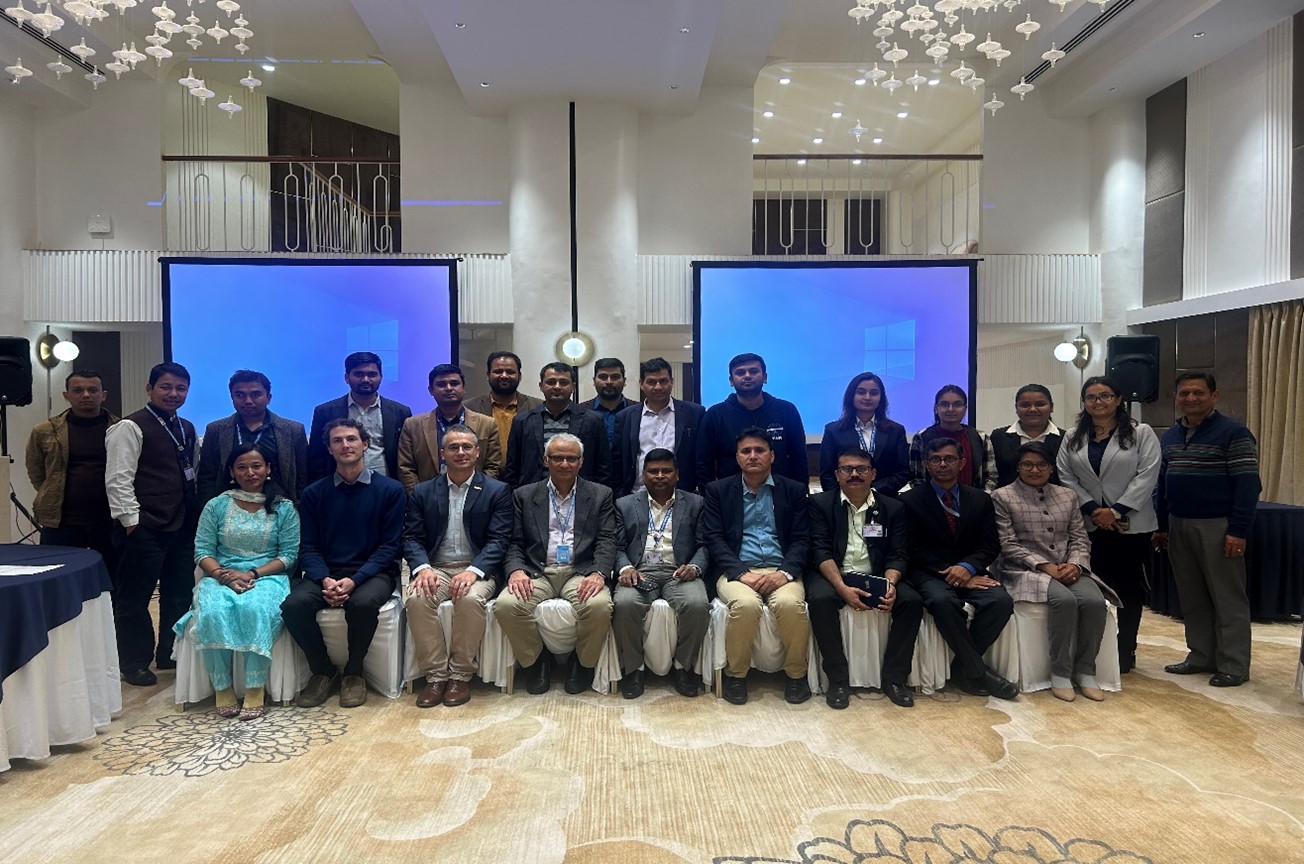
WHE, WHO Country Office for Nepal and the Ministry of Health conducted ZIDAR Nepal Capacity building workshop on 22-23 March 2023 to perform refinements and optimization of the model structure in consultation with local experts. (Photo-IHM/WHE, SEARO).
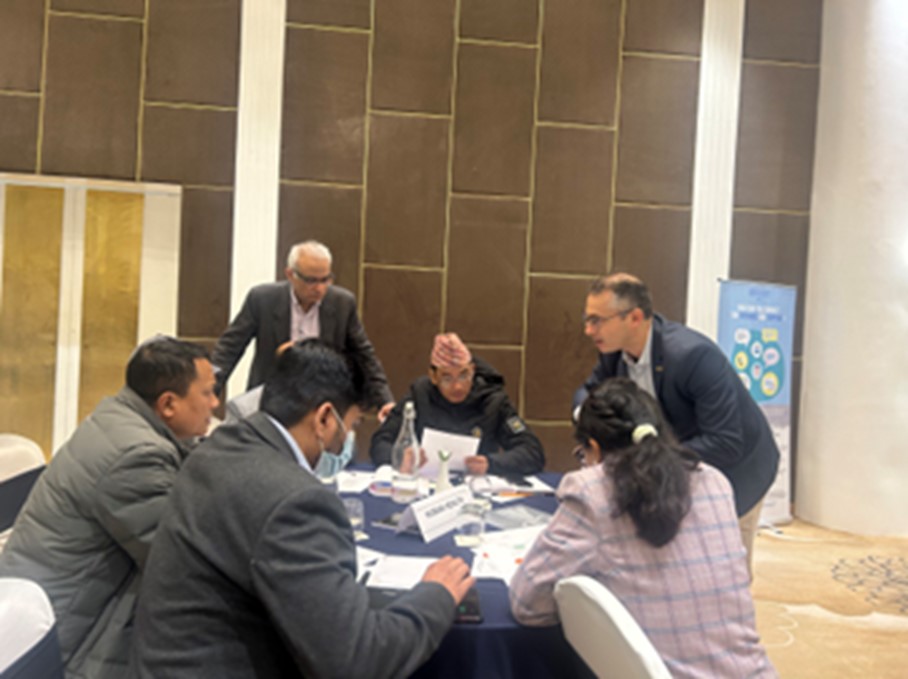
WHE, WHO Country Office for Nepal and the Ministry of Health conducted ZIDAR Nepal Capacity building workshop on 22-23 March 2023 to provide capability and training in model development and validation. (Photo-IHM/WHE, SEARO)
The other strategic area in the Global influenza strategy that WHE focused on was “research and innovation.” Global, regional, and national estimates of influenza burden of disease (BoD) are a key output in the PIP PC’s high-level implementation plan (HLIP). The HLIP III has identified influenza health and economic burden of disease (BoD) estimation as a deliverable under the output1: Policy plans. Number of MS with published disease burden estimates based on data collected since 2011 is an indicator in the Monitoring and Evaluation framework. Further, it is an essential baseline activity to inform decision-making on influenza vaccine policies and broader influenza pandemic preparedness initiatives.
Accordingly, WHE maintained the momentum in the strategic area of “Research and innovation” under the global influenza strategy to serve the objective of BoD estimation. In the past, BOD estimation efforts in the region have been limited in scale and scope. Regional Office continued its discussions and planning with priority MS to support systematic, and standardized BOD studies. In addition to planning BoD studies in select Member States with good influenza surveillance, feasibility assessment was also discussed with interested MS in 2023. Both these activities will be rolled out in 2024.
WHE published the bibliometric analysis of medical literature on Influenza published from Member States in the Region across five streams of WHO Public Health Research Agenda for Influenza[1]. The analysis covered peer reviewed publications published approximately over the past 21 years (01 January 2000 –31 December 2021). The literature review provided important insights into and gaps in influenza related research evidence in the Region. The analysis also identified major areas for providing recommendations to Member States and the Regional Office with a view to prioritizing avenues for future research while aligning it with global, regional, and national priorities.
Under the strategic objective of Pandemic preparedness and response in the Global Influenza Strategy , WHE conducted a Regional workshop for planning for national access, allocation, and deployment of influenza pandemic medical countermeasures in Thailand. The workshop included a tabletop/simulation/gaming exercises, educational presentations, and group work activities. These methods enabled participants to identify areas for improvement in national vaccine deployment planning and tools to enable the revision or development of new deployment and vaccination plans for pandemic influenza. Participants identified areas for improving drafts of their national medical countermeasures deployment action plans and familiarized with available WHO tools supporting development of plans for medical countermeasures deployment. At the end of the meeting participating countries (Bhutan, Thailand, Nepal, Timor Leste, India) articulated next steps and discussed how WHO could support their efforts technically.[1] Ranjan Wijesinghe P, Sharma D, Vaishnav B, Mukherjee R, Pawar P, Mohapatra A, Buddha N, Ceniza Salvador E, Kakkar M. An appraisal of peer-reviewed published literature on Influenza, 2000-2021 from countries in South-East Asia Region. Front Public Health. 2023 Apr 17;11:1127891. doi: 10.3389/fpubh.2023.1127891. PMID: 37139386; PMCID: PMC10149947.
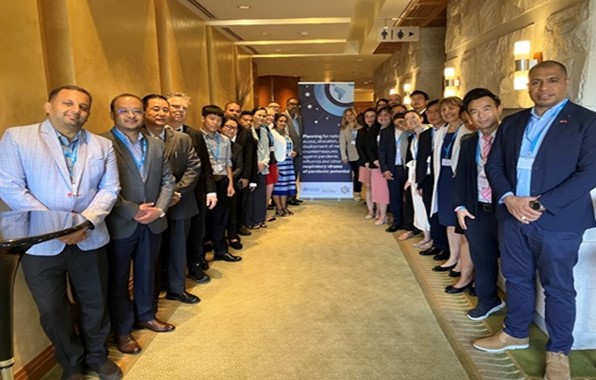
WHO conducted a regional workshop on planning for national access, allocation, and deployment of influenza pandemic medical countermeasures in Thailand for selected five MS. (Photo-IHM/WHE, SEARO)
Global Influenza strategy emphasizes fostering partnerships with state and non-state actors. Guided by the above, WHE at the Regional Office continued to work with key partners namely Mahidol-Oxford Research Unit (MORU) Thailand, US CDC, WHO Collaborating Centers for Influenza, Integrated Management of Adolescent and Adult Illness (IMAI) Alliance USA, University of Queensland , Australia, National Institute of Epidemiology, Chennai, India, National Institute of Virology, Pune , India and Council of Scientific and Industrial Research (CSIR) - Institute of Genomics and Integrative Biology, India. United Kingdom Institute of Development Studies (University of Sussex).
Pandemic Influenza Preparedness -Implementation of HLIP-III
WHO Secretariat together with many stakeholders prepared the new HLIP-III (2023-30) and conducted the evaluation of the implementation of the HLIP-II (2018-23). While WHE managed the project of implementation of HLIP in region, it worked in “Regulatory “output with UHC/ health systems department and UHC/Communicable diseases (CDS) department which were jointly responsible for ensuring timely access to quality assured pandemic products. Similarly, Immunizations and Vaccines development (IVD) unit of the UHC/Communicable diseases department supported optimizing plans for effective and efficient deployment of pandemic supplies under “Deployment” output. Both these departments were actively involved in prioritizing MS for implementing the output” Access to Counter Measures” in PIP workplans related to new HLIP-III. WHE and these two departments contributed immensely to the independent evaluation on HLIP-II conducted.
